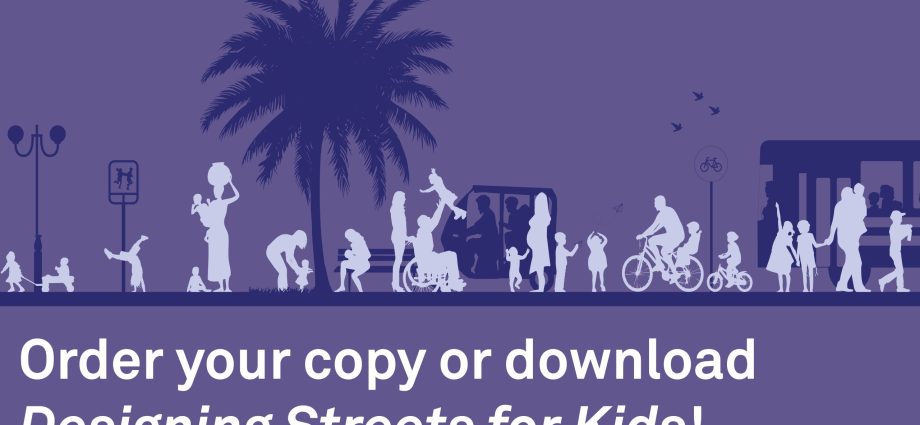The Global Designing Cities Initiative (GDCI) today launched its Designing Streets for Kids guide in Arabic in Amman, Jordan, withJordan’s Public Security Directorate and urban design experts.
The award-winning guide serves as a valued roadmap for creating holistic, child-centered and child-influenced street redesigns. It provides practical guidance for key areas such as school zones and neighborhood streets, as well as in high- trafficked environments including commercial streets and intersections. The new Arabic edition joins nine others, in languages ranging from Turkish to Vietnamese, making it an essential tool that offers actionable strategies, best practices and innovative designs for urban streets that put the needs of children, babies, and caregivers first.
Used worldwide by cities from Cuenca, Ecuador to Kuala Lumpur, Malaysia, Designing Streets for Kids addresses the critical issues that children, from birth through their teenage years, face because of how streets and public spaces are often designed… The guide highlights the often-overlooked importance of the early years (ages 0–5) and shows how holistic street design can improve safety, health, and mobility for all. Such designs offer more authentic choices for moving beyond the car, whether walking, cycling, or taking transit, while promoting cleaner air, stronger community connections, greater resilience, and more opportunities for kids to learn and play along each journey. With traffic-related collisions as the leading cause of death among people aged 5 to 29 worldwide, the guide places safety at the core of every strategy. At the same time, it ensures that streets can be comfortable, enjoyable, and inspirational places to be, for children, caregivers, and communities alike.
“Guidance in Designing Streets for Kids aligns with the ministry’s efforts to create safer and more inclusive urban environments for children, which is integral to the ministry’s vision to improve quality of life and urban services across Jordanian cities,” said Nidal Abu Arabi, secretary-general of the Ministry of Local Administration. “The guide’s availability in Arabic provides a valuable opportunity to support city development and quality of life enhancement.”
Designing Streets for Kids arrival in Arabic is timely for several reasons. With more than 400 million people in 22 countries across the Middle East and North Africa (MENA) and their diaspora speaking
Arabic, it is the fifth-most spoken language in the world. Young people under 24 years old in the MENA region are also its largest cohort, accounting for nearly half its population. In parallel, many Middle Eastern cities have rapidly urbanized in recent years in a car-centric manner. This has increased worries about chronic health issues linked to air pollution and sedentary lifestyles.
This new guide brings cities like Amman, Cairo, Dubai and Riyadh and others a window of opportunity to ensure equitable access to education, opportunities, and public life, while improving overall well-being through proven community- and kid-driven street redesigns, policies and strategies. Designing Streets for Kids helps planners and practitioners consider safe and active ways for children to both reach school and join healthy activities in playgrounds, parks and libraries. Reshaping the region’s urban streets will help families boost learning in and outside classrooms–ultimately improving young people’s educational and employment prospects.
“Too many children in Jordan are not playing and exploring outside enough because their families worry about safety and road traffic,” said Farah Jadallah, Jordan representative at the Van Leer Foundation. “This reality is shared by many children and parents across the Arab World. The Arabic guide of Streets for Kids gives cities like Amman, Irbid and Aqaba in Jordan a roadmap on how to transform streets into safe environments that encourage connection and learning. Street by street – this is the way forward for creating better cities, healthy families and prosperous societies.”
With 24,000 downloads, Designing Streets for Kids is known for its visually powerful renderings and before and after photos featured in 62 case studies and snapshots from 48 cities across the globe. The guide also shows how to engage children throughout the planning process—an often-overlooked approach that can dramatically transform how streets are designed and used.
“Reliable mobility options and access to safe, healthy streets is a human right, and Designing Streets for Kids provides actionable strategies for ensuring equitable access to these vital public spaces,” said Skye Duncan, executive director of GDCI. “With the Arabic translation of this award-winning publication, millions more people across the globe can access this information in their native language, helping to ensure that more kids not only survive, but thrive on their local streets.”
Designing Streets for Kids is the flagship publication of GDCI’s Streets for Kids program. Since its 2018 founding, the program has directly improved the daily journeys and livelihood of more than 140,000 children worldwide with the generous support from Fondation Botnar, FIA Foundation, Van Leer Foundation and Bloomberg Philanthropies. The guide is a companion to and draws from GDCI’s award-winning Global Streets Design Guide, soon to be also available in Arabic.
About Streets for Kids The Streets for Kids program aims to help improve the lives of kids in cities. To do so, we inspire leaders, inform practitioners, and empower communities to understand cities through the lens of children and their caregivers and to take action on their streets to ensure a cleaner, healthier, and safer future. Since the program’s launch in 2018, we have collaborated with over 60 cities across the globe to deliver child-focused street redesigns, build local capacity, implement projects on the ground, and to catalyze systemic policy changes, based on the principles and best practices from our award-winning guide. About the Global Designing Cities Initiative (GDCI)
The Global Designing Cities Initiative’s mission is to transform streets around the world, inspiring leaders, practitioners, and communities to imagine what’s possible when we design streets that put people first. To learn more, visit globaldesigningcities.org
About the FIA Foundation
The FIA Foundation is an international charity, working closely with grant partners to shape projects and advocate to secure change in policy and practice. Our objective is safe and healthy journeys for all, whether it is the daily walk to school or the final lap of a Grand Prix.
About the Van Leer Foundation
The Van Leer Foundation is an independent Dutch organisation working globally to foster inclusive societies where all children and communities can flourish. We bring together people with different perspectives and support them to achieve large-scale impact. Our support involves a unique combination of funding, networks, executive education, technical assistance and knowledge. Visit: www.vanleerfoundation.org















